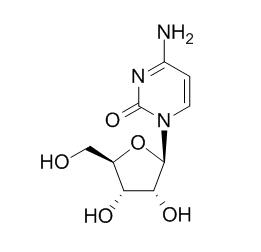Cytidine
Cytidine is a nucleoside molecule that is formed when cytosine is attached to a ribose ring, cytidine is a component of RNA.Cytidine deaminases APOBEC3G and APOBEC3F interact with human immunodeficiency virus type 1 integrase and inhibit proviral DNA formation.
Inquire / Order:
manager@chemfaces.com
Technical Inquiries:
service@chemfaces.com
Tel:
+86-27-84237783
Fax:
+86-27-84254680
Address:
1 Building, No. 83, CheCheng Rd., Wuhan Economic and Technological Development Zone, Wuhan, Hubei 430056, PRC
Providing storage is as stated on the product vial and the vial is kept tightly sealed, the product can be stored for up to
24 months(2-8C).
Wherever possible, you should prepare and use solutions on the same day. However, if you need to make up stock solutions in advance, we recommend that you store the solution as aliquots in tightly sealed vials at -20C. Generally, these will be useable for up to two weeks. Before use, and prior to opening the vial we recommend that you allow your product to equilibrate to room temperature for at least 1 hour.
Need more advice on solubility, usage and handling? Please email to: service@chemfaces.com
The packaging of the product may have turned upside down during transportation, resulting in the natural compounds adhering to the neck or cap of the vial. take the vial out of its packaging and gently shake to let the compounds fall to the bottom of the vial. for liquid products, centrifuge at 200-500 RPM to gather the liquid at the bottom of the vial. try to avoid loss or contamination during handling.
Plants (Basel).2021, 10(5):951.
Toxins (Basel).2022, 14(12):824.
World J Mens Health.2019, 10.5534
Sci Rep.2021, 11(1):11936.
Antioxidants (Basel).2023, 13(1):12.
Biomedicines.2022, 10(2):463.
Nat Commun.2023 Dec 20;14(1):8457.
Sci Rep.2019, 9(1):4646
Research Square2021, 10.21203.
J Pharm Biomed Anal.2024, 247:116257.
Related and Featured Products
RNA. 2001 Mar; 7(3): 395–404.
The effect of cytidine on the structure and function of an RNA ligase ribozyme.[Pubmed:
11333020]
METHODS AND RESULTS:
A Cytidine-free ribozyme with RNA ligase activity was obtained by in vitro evolution, starting from a pool of random-sequence RNAs that contained only guanosine, adenosine, and uridine. This ribozyme contains 74 nt and catalyzes formation of a 3',5'-phosphodiester linkage with a catalytic rate of 0.016 min(-1). The RNA adopts a simple secondary structure based on a three-way junction motif, with ligation occurring at the end of a stem region located several nucleotides away from the junction. Cytidine was introduced to the Cytidine-free ribozyme in a combinatorial fashion and additional rounds of in vitro evolution were carried out to allow the molecule to adapt to this added component. The resulting Cytidine-containing ribozyme formed a 3',5' linkage with a catalytic rate of 0.32 min(-1).
CONCLUSIONS:
The improved rate of the Cytidine-containing ribozyme was the result of 12 mutations, including seven added Cytidines, that remodeled the internal bulge loops located adjacent to the three-way junction and stabilized the peripheral stem regions.
Journal of Virology, 2007 , 81 (13) :7238.
Cytidine deaminases APOBEC3G and APOBEC3F interact with human immunodeficiency virus type 1 integrase and inhibit proviral DNA formation[Reference:
WebLink]
APOBEC3G (A3G) is a single-stranded DNA Cytidine deaminase that targets retroviral minus-strand DNA and has potent antiviral activity against diverse retroviruses. However, the mechanisms of A3G antiviral functions are incompletely understood.
METHODS AND RESULTS:
Here we demonstrate that A3G, A3F, and, to a lesser extent, the noncatalytic A3GC291S block human immunodeficiency virus type 1 (HIV-1) replication by interfering with proviral DNA formation. In HIV-1 virions, A3G interacted with HIV-1 integrase and nucleocapsid, key viral factors for reverse transcription and integration. Unlike A3G, the weak antiviral A3C Cytidine deaminase did not interact with either of these factors and did not affect viral reverse transcription or proviral DNA formation.
CONCLUSIONS:
Thus, multiple steps of the HIV-1 replication cycle, most noticeably the formation of proviral DNA, are inhibited by both Cytidine deamination-dependent and -independent mechanisms.



